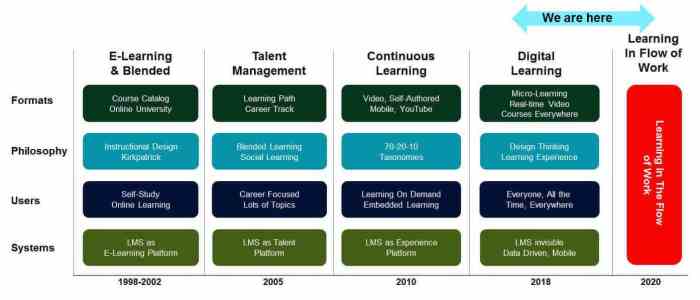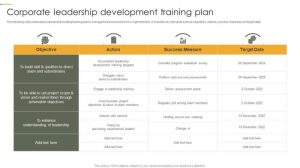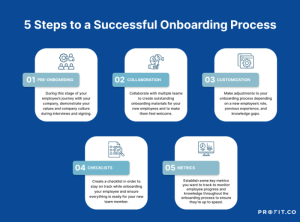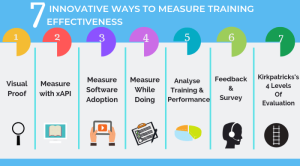
Effective corporate training is no longer a luxury; it’s a necessity for sustained growth and competitive advantage. This guide delves into the critical aspects of designing, implementing, and evaluating high-impact corporate training programs. We’ll explore various methodologies, assess effective metrics for measuring ROI, and examine future trends shaping the landscape of corporate learning and development.
From identifying the characteristics of a truly “best” course to understanding the synergistic relationship between training and corporate expansion, we’ll provide a practical framework for organizations seeking to maximize their investment in employee development. We will also consider the challenges inherent in implementation and offer solutions to ensure successful program rollout.
Defining “Best” Corporate Training Courses

Effective corporate training is crucial for a company’s success. It enhances employee skills, boosts productivity, and fosters a culture of continuous improvement. However, not all training programs are created equal. Identifying and implementing “best” corporate training courses requires a careful consideration of several key factors.
Key Characteristics of High-Quality Corporate Training
High-quality corporate training is characterized by its alignment with business objectives, engaging delivery methods, and measurable impact. Courses should be designed to address specific skill gaps and contribute directly to improved performance. Furthermore, effective training incorporates diverse learning styles and provides opportunities for practice and feedback. A strong focus on relevance and practicality, ensuring trainees can immediately apply learned skills to their work, is paramount.
Finally, the training should be adaptable to the evolving needs of the business and its employees.
Factors Contributing to Effective Corporate Training Programs
Several factors contribute to the effectiveness of corporate training. These include a clear understanding of learning objectives, well-designed curriculum, skilled and engaging instructors, and appropriate learning technologies. Regular evaluation and feedback mechanisms are essential to track progress and make necessary adjustments. Furthermore, a supportive learning environment that encourages participation and collaboration significantly enhances the learning experience.
Finally, integrating training with ongoing performance management strengthens its impact and ensures long-term retention of knowledge and skills.
Comparison of Training Methodologies
Different training methodologies offer unique advantages and disadvantages. Online training, for example, offers flexibility and scalability, but may lack the personal interaction of in-person sessions. In-person training provides opportunities for immediate feedback and networking, but can be costly and logistically challenging. Blended learning, which combines online and in-person elements, seeks to leverage the strengths of both approaches. The optimal choice depends on the specific training objectives, target audience, budget, and available resources.
Training Methodologies: Pros, Cons, and Best Use Cases
| Training Method | Pros | Cons | Best Use Cases |
|---|---|---|---|
| Online Training | Cost-effective, scalable, accessible, flexible scheduling | Can lack personal interaction, requires self-discipline, potential for technical issues | Compliance training, onboarding, soft skills development, large-scale training |
| In-Person Training | Facilitates interaction, immediate feedback, networking opportunities, high engagement | Expensive, logistically challenging, limited scalability, inflexible scheduling | Team building, leadership development, specialized technical training, hands-on skills training |
| Blended Learning | Combines the benefits of online and in-person training, flexibility and engagement | Requires careful planning and coordination, may be more complex to manage | Most training scenarios, particularly those requiring a mix of theoretical knowledge and practical application |
Types of Corporate Training Courses
Corporate training encompasses a vast landscape of programs designed to enhance employee skills, knowledge, and performance. These courses are tailored to specific industry needs, departmental roles, and skill gaps, ultimately contributing to organizational success. The categorization of these courses can be approached from several perspectives, offering a nuanced understanding of their breadth and depth.
Categorizing corporate training courses effectively requires considering the target audience and the desired learning outcomes. This involves analyzing industry-specific regulations and best practices, departmental responsibilities, and the skills necessary for individual roles and organizational growth. A well-structured training program considers all these factors to maximize its impact.
Categorization by Industry
Different industries require specialized training to address their unique challenges and regulatory requirements. For instance, the technology sector necessitates training on emerging technologies, cybersecurity, and software development, while the financial industry focuses on compliance, risk management, and investment strategies. Healthcare training prioritizes patient safety, medical procedures, and ethical considerations.
- Technology: Cloud computing, cybersecurity awareness, software development (Agile methodologies, specific programming languages), data analytics, AI and machine learning.
- Finance: Financial modeling, risk management, compliance (e.g., KYC/AML), investment banking, regulatory updates (e.g., Dodd-Frank).
- Healthcare: Patient safety protocols, HIPAA compliance, medical coding and billing, electronic health records (EHR) systems, CPR and first aid.
Categorization by Department
Departmental training focuses on the specific needs and responsibilities of each team. This ensures employees acquire the skills and knowledge necessary to excel in their roles and contribute effectively to the overall organizational goals. Effective departmental training leads to improved efficiency and productivity within each team.
- Sales: Sales techniques, customer relationship management (CRM) software, negotiation skills, product knowledge, lead generation.
- Marketing: Digital marketing, social media marketing, content marketing, /SEM, marketing analytics.
- Human Resources: Employment law, employee relations, performance management, recruitment, compensation and benefits.
Categorization by Skillset
Focusing on specific skillsets allows for targeted training to address particular gaps or enhance existing capabilities. This approach is particularly effective in upskilling or reskilling employees to meet evolving organizational needs. Examples include leadership development, communication skills, and technical proficiency.
- Leadership Development: Strategic thinking, decision-making, communication, team building, conflict resolution, mentorship.
- Communication Skills: Active listening, public speaking, written communication, nonverbal communication, intercultural communication.
- Technical Skills: Software proficiency (Microsoft Office Suite, specific industry software), data analysis, project management software (e.g., Asana, Jira).
Curriculum Design for Leadership Development Training
A comprehensive leadership development program typically incorporates a blended learning approach, combining classroom instruction, online modules, simulations, and on-the-job coaching. The curriculum is structured to progressively build leadership capabilities, starting with foundational concepts and culminating in advanced strategic thinking and decision-making skills.
A typical curriculum might include modules on:
- Leadership Styles and Theories: Exploring different leadership approaches and their effectiveness in various contexts.
- Communication and Influence: Developing skills in effective communication, persuasion, and negotiation.
- Strategic Thinking and Decision-Making: Enhancing analytical skills and the ability to make informed decisions under pressure.
- Team Building and Motivation: Learning strategies to build high-performing teams and motivate individuals.
- Conflict Resolution and Negotiation: Developing skills to manage and resolve conflicts effectively.
- Mentorship and Coaching: Learning how to mentor and coach team members to foster their growth and development.
Flowchart of a Typical Corporate Training Program
The following flowchart illustrates the typical structure of a corporate training program. This provides a visual representation of the key stages involved, from needs assessment to evaluation and improvement.
[Imagine a flowchart here. The flowchart would begin with a “Needs Assessment” box, branching to “Learning Objectives” and “Training Design.” “Training Design” would branch to “Content Development,” “Delivery Method Selection,” and “Platform Selection.” These would all feed into “Training Implementation.” “Training Implementation” would lead to “Evaluation” and then to “Feedback and Improvement.” Feedback and improvement would loop back to “Needs Assessment,” completing the cycle.
Each box would have arrows indicating the flow of the process.]
Evaluating Corporate Training Course Effectiveness

Determining the effectiveness of corporate training programs is crucial for maximizing return on investment (ROI) and ensuring employee skill development aligns with organizational goals. A robust evaluation process involves multiple methods, from quantitative metrics to qualitative feedback, providing a comprehensive understanding of the training’s impact.
Metrics for Assessing Training Success
Several key metrics can be used to assess the success of a corporate training program. These metrics offer a quantitative view of the training’s impact on employee performance and overall business outcomes. For instance, measuring improvements in employee knowledge and skills post-training is essential. This can be achieved through pre- and post-training assessments, evaluating the difference in scores to gauge knowledge gain.
Furthermore, tracking changes in employee performance metrics, such as sales figures, customer satisfaction scores, or error rates, directly linked to the training’s subject matter, provides a tangible measure of its effectiveness. Finally, observing improvements in key business outcomes, like increased productivity, reduced operational costs, or improved product quality, demonstrates the training’s contribution to the organization’s overall success. These metrics, when collected and analyzed effectively, provide valuable insights into the training program’s efficacy.
Best Practices for Measuring ROI of Corporate Training
Measuring the return on investment (ROI) of corporate training requires a structured approach. A crucial step is to clearly define the training’s objectives and expected outcomes beforehand. This allows for a precise measurement of the achieved results against the predefined goals. For example, if the training aims to improve sales conversion rates, the ROI can be calculated by comparing the increase in sales revenue after the training to the total cost of the program.
The formula often used is:
ROI = (Return – Investment) / Investment
. This calculation should account for all associated costs, including training materials, instructor fees, employee time, and technology. It’s important to note that calculating ROI for soft skills training, such as leadership development, might require more qualitative assessments and focus on indirect benefits like improved employee morale and reduced turnover.
Gathering Feedback from Employees
Collecting employee feedback is vital for understanding the training’s impact and identifying areas for improvement. A multi-faceted approach ensures a comprehensive understanding of the trainees’ experience. This feedback can inform future training design and delivery, ensuring the program remains relevant and effective.
- Post-Training Surveys: These questionnaires can assess knowledge retention, satisfaction with the training content and delivery, and perceived value. Examples of questions include: “How much did you learn from this training?”, “How satisfied were you with the instructor?”, and “How likely are you to apply what you learned in your daily work?”.
- Focus Groups: Facilitated discussions with small groups of trainees allow for in-depth exploration of their experiences and provide valuable qualitative insights that may not be captured through surveys.
- Individual Interviews: One-on-one conversations with select trainees offer a personalized perspective and allow for more detailed exploration of specific aspects of the training.
- Observations: Direct observation of employees applying the learned skills in their work environment provides a valuable measure of practical application and skill transfer.
Corporate Growth and Corporate Training
Effective corporate training programs are not merely a cost; they are a strategic investment directly impacting a company’s bottom line and long-term success. A well-designed training initiative fosters a culture of continuous learning, ultimately driving corporate growth through increased productivity, improved employee engagement, and a more adaptable workforce.Effective corporate training directly influences corporate growth through a multitude of interconnected pathways.
Investing in employee skill development translates into a more productive and efficient workforce. This heightened productivity directly contributes to increased revenue, improved operational efficiency, and a stronger competitive advantage in the marketplace. Furthermore, skilled employees are better equipped to innovate and adapt to changing market demands, fostering a dynamic and resilient organization.
Employee Skill Development and Increased Productivity
Investing in training equips employees with the necessary skills and knowledge to perform their jobs more effectively. This leads to a measurable increase in productivity. For example, a company that invests in software training for its sales team might see a significant rise in sales conversion rates. Similarly, training employees on lean manufacturing techniques could lead to reduced waste and increased output in a production setting.
The enhanced efficiency translates directly into cost savings and increased profitability. Improved efficiency allows employees to complete tasks faster and more accurately, minimizing errors and reducing rework.
Improved Employee Engagement and Business Expansion
Employee engagement is intrinsically linked to corporate growth. When employees feel valued and invested in, they are more likely to be motivated, productive, and committed to the company’s success. Corporate training programs that are relevant, engaging, and tailored to individual employee needs significantly boost engagement levels. This increased engagement translates to higher retention rates, reduced recruitment costs, and a more positive work environment.
A highly engaged workforce is more likely to contribute innovative ideas, improving processes and driving business expansion. For instance, companies with high employee engagement often report higher customer satisfaction rates and stronger brand loyalty.
The Positive Feedback Loop Between Training and Growth
Imagine a circular diagram. At the top, we have “Corporate Training Initiatives,” representing the investment in employee development programs. An arrow moves clockwise to “Improved Employee Skills and Knowledge,” reflecting the direct outcome of effective training. The next arrow points to “Increased Productivity and Efficiency,” demonstrating the impact of enhanced skills on the company’s operational performance. This leads to “Higher Revenue and Profitability,” illustrating the financial benefits of increased productivity.
From here, another arrow points to “Business Expansion and Growth,” highlighting the overall impact on the company’s trajectory. Finally, the last arrow connects back to “Corporate Training Initiatives,” demonstrating that the increased revenue and profitability allow for further investment in training, thus creating a continuous cycle of improvement and growth. This positive feedback loop ensures that the investment in training continuously fuels further growth and success.
Future Trends in Corporate Training
The landscape of corporate training is undergoing a rapid transformation, driven by technological advancements and evolving learning preferences. The future of effective learning and development hinges on embracing innovative approaches that cater to the diverse needs of a modern workforce, focusing on personalized, engaging, and readily accessible experiences. This shift necessitates a move away from traditional methods towards more dynamic and technologically integrated solutions.
Emerging Technologies Transforming Corporate Training
The integration of emerging technologies is revolutionizing how corporations approach employee training. Virtual Reality (VR) and Augmented Reality (AR) are creating immersive and interactive learning environments, allowing employees to practice skills in simulated scenarios without the risks or costs associated with real-world training. For example, surgeons can practice complex procedures in a VR operating room, and factory workers can learn to operate machinery safely in a simulated AR environment.
Artificial Intelligence (AI) is also playing a significant role, personalizing learning pathways, providing intelligent feedback, and automating administrative tasks. AI-powered chatbots can answer employee questions instantly, freeing up trainers to focus on more complex learning needs. Furthermore, AI algorithms can analyze learning data to identify knowledge gaps and tailor training content accordingly, optimizing learning outcomes.
Predictions for the Future of Corporate Learning and Development
Several key predictions shape the future of corporate learning and development. Microlearning, delivering bite-sized learning modules, will become increasingly prevalent, catering to the shorter attention spans and busy schedules of today’s workforce. Gamification, incorporating game mechanics into training programs, will continue to grow in popularity, enhancing engagement and motivation. The rise of the learning experience platform (LXP) will consolidate various learning resources into a single, accessible platform, improving the overall learning experience.
We can expect to see a greater emphasis on social learning, encouraging collaboration and knowledge sharing among employees. For instance, companies like Google and Salesforce are already utilizing internal social networks for knowledge sharing and peer-to-peer learning. Finally, the focus will shift from instructor-led training towards self-directed learning, empowering employees to take control of their professional development.
Innovative Approaches to Corporate Training
Several innovative approaches are reshaping corporate training. Personalized learning pathways, tailored to individual employee needs and learning styles, will become the norm. This might involve AI-driven assessments that identify skill gaps and recommend relevant learning resources. Simulation-based training, using VR/AR technologies, will provide realistic and safe environments for practicing complex skills. For example, pilots can simulate flight scenarios in a VR environment, and customer service representatives can practice handling difficult customer interactions in a virtual setting.
Furthermore, blended learning approaches, combining online and in-person training, will optimize the learning experience by leveraging the strengths of both methods. The integration of performance support tools, such as interactive guides and knowledge bases, will provide readily accessible support when employees need it most. Finally, incorporating microlearning modules will allow for just-in-time learning, delivering relevant information precisely when employees need it to perform their tasks effectively.
The Impact of Personalized Learning Experiences
Personalized learning experiences are poised to significantly impact corporate training effectiveness. By tailoring training content to individual employee needs, learning styles, and skill levels, organizations can achieve higher engagement, improved knowledge retention, and ultimately, better performance. AI-powered learning platforms can analyze individual learning data to identify strengths and weaknesses, suggesting personalized learning paths and resources. This approach ensures that employees focus their time and effort on areas where they need the most improvement, maximizing the return on investment in training.
For example, a sales representative struggling with closing deals could receive targeted training modules focusing on negotiation techniques and objection handling, while a highly proficient representative might focus on advanced sales strategies. This targeted approach leads to more efficient and effective learning, boosting employee performance and contributing to the overall success of the organization.
Best Practices for Implementing Corporate Training Programs
Successfully implementing a corporate training program requires meticulous planning and execution. A well-structured program not only enhances employee skills but also contributes significantly to organizational growth and overall success. This involves a strategic approach encompassing needs assessment, program design, delivery, and evaluation.Effective implementation hinges on a clear understanding of the organization’s training needs, the selection of appropriate training methods, and the commitment of both trainers and trainees.
Careful consideration must be given to factors such as budget allocation, resource availability, and the overall learning environment to maximize the program’s impact.
Planning a Corporate Training Program
The planning phase is critical for a successful corporate training program. It involves a detailed analysis of the organization’s goals, identification of skill gaps, and the development of a comprehensive training plan. This plan should Artikel learning objectives, training methods, timelines, and evaluation strategies. A well-defined budget and resource allocation are also essential components of the planning process.
For example, a company implementing a new software system might dedicate resources to hands-on training sessions, online tutorials, and mentoring programs to ensure employees master the new technology.
Effective Communication Strategies for Training Initiatives
Communicating the value and importance of training initiatives is paramount for securing employee buy-in and maximizing participation. This requires a multi-faceted communication strategy that utilizes various channels to reach the target audience. Effective communication strategies include clear and concise announcements, personalized invitations, and regular updates on training progress. For instance, using internal newsletters, emails, and company intranet announcements, alongside one-on-one conversations with managers, ensures everyone is informed and engaged.
Highlighting success stories from past training programs can also motivate participation.
Potential Challenges in Implementing Corporate Training and Their Solutions
Implementing corporate training programs often encounters obstacles. One common challenge is resistance to change from employees who may be hesitant to adopt new skills or methods. This can be addressed by emphasizing the benefits of the training and providing adequate support and encouragement. Another challenge is ensuring consistent participation and engagement throughout the training program. Utilizing interactive learning methods, incorporating gamification elements, and providing regular feedback can help maintain engagement.
Finally, budget constraints can limit the scope and quality of training. Creative solutions such as leveraging online learning platforms, partnering with external training providers, and prioritizing high-impact training initiatives can mitigate these limitations. For example, instead of expensive in-person seminars, a company could utilize cost-effective online courses supplemented with virtual mentoring sessions.
Checklist for Designing and Delivering a Corporate Training Program
A comprehensive checklist ensures all critical aspects of the training program are addressed. This checklist should include:
- Needs assessment: Identifying skill gaps and learning objectives.
- Program design: Choosing appropriate training methods and materials.
- Budget allocation: Determining the financial resources required.
- Resource allocation: Identifying trainers, facilities, and technology.
- Timeline development: Establishing a realistic training schedule.
- Training delivery: Implementing the training program effectively.
- Evaluation: Assessing the effectiveness of the training program.
- Feedback mechanisms: Gathering input from participants for continuous improvement.
- Post-training support: Providing ongoing support and resources to trainees.
Following this checklist helps ensure a structured and effective corporate training program. A robust evaluation process is key to measuring its impact on employee performance and organizational outcomes.
Ultimately, the success of any corporate training program hinges on a strategic approach that aligns with business objectives, incorporates diverse learning styles, and leverages data-driven insights to continuously improve effectiveness. By understanding the key elements discussed—from choosing the right training methodology to measuring ROI and adapting to future trends—organizations can empower their employees and drive significant business growth. Investing in the “best” corporate training courses is not merely an expense; it’s a strategic investment in the future of the company.
FAQ Summary
What is the average cost of corporate training courses?
Costs vary significantly depending on factors such as course length, delivery method (online vs. in-person), number of participants, and the specific content. It’s best to obtain quotes from multiple providers.
How do I choose the right training provider?
Consider factors like experience, industry expertise, client testimonials, course content relevance, and the provider’s approach to learning and development. Request demos and compare offerings before making a decision.
How can I measure the effectiveness of a training program beyond ROI?
Beyond financial metrics, consider employee feedback, skill assessments, changes in employee behavior, and the impact on team performance and overall productivity. Qualitative data can offer valuable insights.
What are some common challenges in implementing corporate training?
Common challenges include securing buy-in from employees and management, scheduling conflicts, limited budgets, and difficulty measuring the impact of training initiatives. Careful planning and communication can mitigate these issues.




